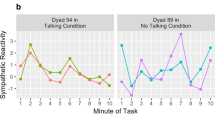Abstract
The hypothesis is experimentally examined that a positive behavioral repertoire can ameliorate the negative social impact of aggressive behavior. Sixty-six fourth- through sixth-grade girls viewed and rated a series of videotaped interactions between two female confederates. The proportion of positive to aggressive behavior viewed by each subject was manipulated across six experimental conditions by varying the number of positive behaviors exhibited by one of the confederates (target) while the number of aggressive behaviors displayed by her remained constant (i.e., 0%, 20%, 43%, 60%, 80%, and 100% positive). Each subject provided sociometric ratings of the target and selected trait descriptors that best described her from a checklist. The results indicated that positive behavior exhibited in high rates (80% or more, compared to aggressive behavior) offset the negative effects of aggression on both sociometric ratings and positive and negative descriptors.
Similar content being viewed by others
References
Asarnow, J. R. (1983). Children with peer adjustment problems: Sequential and nonsequential analyses of school behaviors.Journal of Consulting and Clinical Psychology, 51, 709–717.
Bierman, K. L. (1986). The relation between social aggression and peer rejection in middle childhood. In R. J. Prinz (Ed.),Advances in behavioral assessment of children and families (Vol. 2, pp. 151–178). Greenwich, CT: JAI Press.
Cairns, R. B., Cairns, B. D., Neckerman, H. J., Gest, S. D., & Gariepy, J. L. (1988). Social networks and aggressive behavior: Peer support or peer rejection?Developmental Psychology, 24, 815–823.
Cantrell, V. L., & Prinz, R. J. (1985). Multiple perspectives of rejected, neglected, and accepted children: Relation between sociometric status and behavioral characteristics.Journal of Consulting and Clinical Psychology, 53, 884–889.
Coie, J. D., & Dodge, K. A. (1983). Continuities and changes in children's social status: A five-year longitudinal study.Merrill-Palmer Quarterly, 29, 261–282.
Coie, J. D., Dodge, K. A., & Coppotelli, H. (1982). Dimensions and types of social status: A cross-age perspective.Developmental Psychology, 18, 557–570.
Conger, J. C., & Keane, A. P. (1981). Social skills intervention in the treatment of isolated or withdrawn children.Psychological Bulletin, 90, 478–495.
Cowen, E. L., Pederson, A., Babigian, H., Izzo, L. D., & Trost, M. A. (1973). Long-term follow-up of early detected vulnerable children.Journal of Consulting and Clinical Psychology, 41, 438–446.
DeLawyer, D. D. (1987). Modifying Peers' Sociometric Evaluations of Rejected Children: An Analogue Investigation. Unpublished doctoral dissertation, West Virginia University.
DeLawyer, D. D., & Foster, S. L. (1986). The effects of peer relationship on the functions of interpersonal behaviors of children.Journal of Clinical Child Psychology, 15, 127–133.
Dodge, K. A., Coie, J. S., & Brakke, N. P. (1982). Behavior patterns of socially rejected and neglected preadolescents: The roles of social approach and aggression.Journal of Abnormal Child Psychology, 10, 389–410.
Foster, S. L., DeLawyer, D. D., & Guevremont, D. C. (1985). Selecting targets for social skills training with children and adolescents. In K. D. Gadow (Ed.),Advances in learning and behavioral disabilities (Vol. 4, pp. 77–132). Greenwich, CT: JAI.
Foster, S. L., DeLawyer, D. D., & Guevremont, D. C. (1986). A critical incidents analysis of liked and disliked peer behaviors and their situational parameters in childhood and adolescence.Behavioral Assessment, 8, 115–133.
Hartup, W. W., Glazer, J. A., Charlesworth, R. (1967). Peer reinforcement and sociometric status.Child Development, 38, 1017–1024.
Hymel, S. (1986). Interpretations of peer behavior: Affective bias in children and adolescents.Child Development, 57, 431–445.
Hymel, S., Wagner, E., & Butler, L. J. (1990). Reputational bias: View from the peer group. In S. R. Asher & J. D. Coie (Eds.),Peer rejection in children: Origins, consequences, and interventions. Cambridge, MA: Cambridge University Press.
Ledingham, J. E. (1981). Developmental patterns of aggressive and withdrawn behavior in childhood: A possible method for identifying preschizophrenics.Journal of Abnormal Child Psychology, 9, 1–22.
Milich, R., & Landau, S. (1984). A comparison of the social status and social behavior of aggressive and aggressive/withdrawn boys.Journal of Abnormal Child Psychology, 12, 277–288.
Olweus, D. (1979). Stability of aggressive reaction patterns in males: A review.Psychological Bulletin, 86, 852–875.
Willis, L. M., & Foster, S. L. (1990). Differences in children's peer sociometric and attribution ratings due to context and type of aggressive behavior.Journal of Abnormal Child Psychology, 18, 199–215.
Author information
Authors and Affiliations
Rights and permissions
About this article
Cite this article
Nangle, D.W., Foster, S.L. The effects of a positive behavioral context on the social impact of aggressive behavior. J Abnorm Child Psychol 20, 543–553 (1992). https://doi.org/10.1007/BF00911239
Revised:
Issue Date:
DOI: https://doi.org/10.1007/BF00911239




